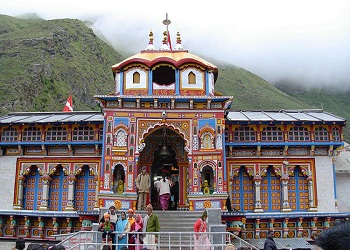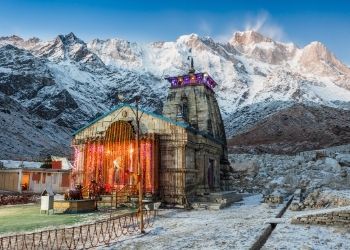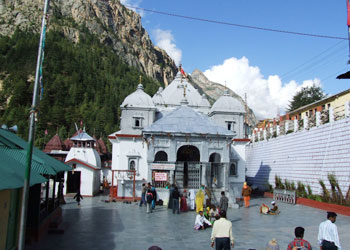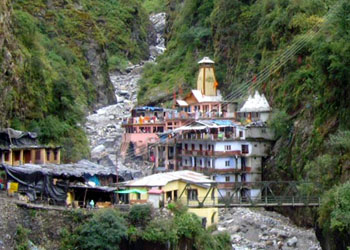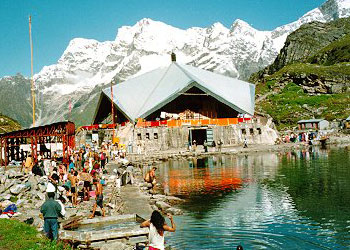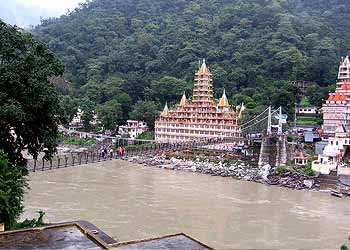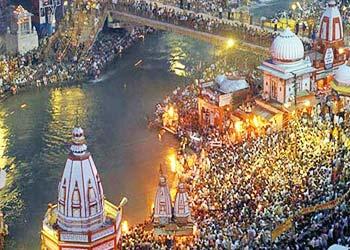Haridwar
want to know about
Haridwar
Haridwar stands as the gateway to the four pilgrimages of Uttaranchal. Geographically and geological, Haridwar, lying at the feet of Shiva's hills, i.e., Shivaliks, in the Haridwar district of Uttaranchal Pradesh, is a doorway. Suryavanshi prince Bhagirath performed penance here to salvage the souls of his ancestors who had perished due to the curse of sage Kapila. The penance was answered and the river Ganga trickled forth form Lord Shiva's locks and its bountiful water revived the sixty thousand sons of king Sagara. In the traditional of Bhagirath, devout Hindus stand in the sacred waters here, praying for salvation of their departed elder. It is doorway to the sources of the Ganga and the Yamuna, 3000 to 4500 meters up into the snowy ranges of the central Himalayas. The 'Aarti' worship of the Ganga after sunset and the floating 'dia' (lamp) is a moving ritual.
HARIDWAR
According to astrologers, the 'Kumbh Fair' takes place when the planet Jupiter enters Aquarius and the Sun enters Aries. According to mythology, 'Devas' (Gods) and 'Asuras' (Demons) churned the ocean to obtain Nectar and when the coveted 'Kumbha' (pitcher) of Nectar (Amrita) which gave immortality was obtained from the depths of ocean, one of the 'Devas' whisked away the 'Kumbha' from the 'Asuras' and evading from the 'Asuras', stopped at four places viz. Haridwar, Allahabad (Prayag), Nasik and Ujjain before he finally arrived into the safety of heaven. A few drops of Nectar are supposed to have spilled over on the water at these four places and sages, saints and pilgrims started periodically to flock to each of these 'Tirthas' to celebrate the divine event. In fact , it is a unique event that blends religious and social features alike.
SIGHT SEEING & EXCURSION
Har ki Pauri : This sacred Ghat was was constructed by kind Vikramaditya in memory of his brother Bhatrihari. It is believed that Bhatrihari eventually came to Haridwar to meditate by the banks of holy Ganga. When he died, his brother constructed a Ghat in his name which later came to be known as Har-Ki-Pauri. This sacred bathing ghat is also known as Brahamakund. The reflection of golden hues of floral diyas in the river river Ganga is the most enchanting sight in the twilight during the Ganga ceremony. The riverbank temple her is hallowed by the imprint of god Hari's foot print. The ghat is regarded the most sacred in Haridwar and this is the most auspicious point to bathe in the Ganga during the 12 year Kumbh and the 6 year Ardh Kumbh.
Sapt Rishi Ashram and Sapt Sarovar : According to legend the seven sages- Kashyap, Vashit, Atri, Vishwamitra, Jaindayani, Bhardwaj and Gautam-were deep in meditation here. The Ganga, not wanting to disturb them and facilitating each her easy approach prefer rather split herself into seven channels around each Rishi.
Mansa Devi Temple : The temple of Goddess Mansa Devi is situated at the top of Bilwa Parwat. The roapway with its brightly coloured cable cars take devotees to the old hilltop of Mansa Devi.
Chandi Devi Temple : The temple of Chandi Devi at the top of Neel Parvat on the other bank of river Ganga was constructed in1929 A.D. by the King of Kashmir-Suchat Singh. It is 3 kms. trek from Chandighat. It is believed that the main statue was established by the Adi Shankaracharya in 8th century Ad. It is situated at a distance of 6 kms. on Neel Parvat on the other bank of the main Ganga river.
Maya Devi Temple : This is an ancient temple of Maya Devi the Adhisthatri deity of Haridwar, known as one of the Siddhapethas. Said to be the places where the hearts and navel of Goddess Sati had fallen.
Daksha Mahadev Temple : The ancient temple of Daksha Mahadev is situated in the south Kankhal town. The mythological story about this place is that kind Daksha Prajapati, father of Sati (Lord Shiva's first wife) performed yagya at this place. Daksha Prajapati did not invite Lord Shiva and Sati felt insulted. Therefore she burned herself in the yagya kund. This incident provoked the disciples and followers of Mahadev who killed King Daksha, but later on Lord Mahadev brought him back to life. Daksha Mahadev temple is thus a tribute to this legend.
Other Temples : Bilkeshwar Mahadev; PawanDham; Bhooma Niketan; Vaishnav Devi Temple; Bharat Mata Mandir; Doodhadhari Temple; Shahi Gurudwara; Jairam Ashram.
Rishikesh (25 Km) : Rishikesh, the 'place of sages' is a celebrated spiritual town on the bank of Ganga and is surrounded by shivalik range of the Himalayas on three sides. It is said that when Raibhya Rishi did hard penances, God appeared by the name of " Hrishikesh " and this area hencefirth came to be known as Rishikesh.
Rishikesh is an ideal destination not only for pilgrims but also for those who want to delve deeper into meditation, Yoga and other aspects of Hinduism. The spiritual haven of the various ashrams is on the eastern side of the Ganga, at Swargashram (on the other bank is the noisy business centre). The ashrams provide lectures and courses to suit everyone's need and quench their thirst for knowledge for fooding and lodging at a reasonable cost.
Dehradun (55 Km) : Dehradun the Capital of Uttaranchal Pradesh is one of the most beautiful resort in the submountain tracts of India, known for its salubrious climate and scenic surroundings. Doon, aside often called, has been a favorite setting ground of the elit for nearly two centuries through its history steches back to many millennia. The name Dehradun appears to be a collection of two word "dera" acmping ground, the Drnocharaya the common Guru of the Pandavas and Kaurava of the Mahabharat and the illustrious son of goddess Ganga, set up an ashram here, near the village of Dwara to perform his devotions at a lonely spot. The place came to be know as Dron Ashram, which eventually became Dun
Earliest tangible evidence of the history of Dehradun is glimpsed from a rock in scrimption of Emperor Ashok, 3rd century, BC, that was discovered in 1860 AD by a Britisher, Mr. Forrest, near Kalsi. The region then formed part of the Emperor's domain, After disappearing from history, perhaps, because it was deserted, it re-emerges in the territory of the Katyuri dynasty of Garhwal. In late 18th century it was conquered by the Gorkhas of Ran Bahadur of Nepal, who were replayed by the British in 1815 AD. Under the British, Dehradun became an elite town with many a fine institution like Forest Research Institute, Doon and Welham Schools, Many more, like the ONGC and Wdia Institute of Himalayan Studies, were added in time. Dehradun has now became an important tourist destination, too for its surroundings offer to interest a visitor.
Mussoorie (90 Km) : Mussoorie is a fascinating Hill Resort commanding a wonderful view of the extensive Himalayan range and at night the gilliering views of Doon Valley. It is pleasant in summer (April to June) and clouding in (July to Aug.) and cool and serene in autumn (Sept. to Nov.) and winter months of Dec. to Feb. is severely bitty cold a time of snow fall, Mussoorie is called "Queen Of Hills" today it is one of the most popular summer destination in the northen hills.
Kanva Rishi Ashram (42 Km) : The ashram is situated on the banks of the Malini river along the forest road to Kotdwar.
Piran Kaliyar (23 Km) : The Dargah of Hazrat Makhdum Alluddin Ali Ahmed "Sabir", lies on the outskirts of Roorkee. It is revered by Muslims and Hindus alike.

